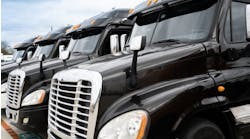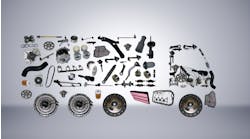During the pandemic, truck drivers are seeing fewer vehicles on the road. This means more running miles and more money. In many urban areas, especially those in the Midwest, traffic jams are in the past. Even busy areas like Metro D.C., are still experiencing traffic levels below pre-pandemic levels.
According to fleet telematics provider Geotab, which has monitored transportation and trade activity during the COVID-19 pandemic, commercial trucks have benefited from reduced passenger traffic. And while traffic has increased on U.S. roads this summer — compared to where it was in the spring — it is still below the normalized, pre-pandemic rate, according to Inrix Trip Trends. Passenger vehicles, in particular, continue to trend at lower rates than before Mid-March, when statewide shutdowns were first implemented across the country.
But once the pandemic subsides, will traffic return to normal with the pre-pandemic rush hours and congestion that have been a staple on U.S. roads for years?
Perhaps. But it may rest on one major factor: People working from home.
Alan Pisarski, author of the Commuting in America series, published by the Transportation Research Board, and who has been preparing reports on commuting since the 1980s, said that his forecasting approach is to see where trends were heading before the pandemic and then evaluate how the pandemic affects that trend. "What has COVID-19 done to those trends? Has it supported the trend? Has it conflicted with that trend?" he asked.
First, the declining trends.
"One long-term trend is a decline in carpooling, which has been going down for a very long time,” Pisarski explained. “There isn't anything that will reverse that trend. The pandemic might even exacerbate it. Carpooling will continue to decline probably greater than in the past."
The same goes for transit. "Transit has been declining in the long term, not as much as carpooling, but in the last five years, it's been declining, and certainly there's nothing in the data that suggests anything that would reverse it,” said Pisarski. “In fact, the pandemic will probably heighten what decline transit has been seeing already."
Pisarski doesn't see any change from more people walking or biking to work, but the true game changer may be working from home, something that the pandemic has brought to the forefront.
Whether or not people continue to work from home and even more join their ranks could move the traffic needle.
"Working from home is the only mode of transportation—if you want to consider it that for this discussion—that has been growing continuously for the last 40 years. COVID-19 supports that trend, and you could argue that drives it even further," says Pisarski.
"Working at home now is 5.3%, if you will, of work travel,” he added. “In 2017, it passed transit usage for the first time. The potential for dramatic influence on traffic is certainly from working at home."
Pisarski also said that carpooling is about 9% of travel and working from home could surpass that.
Muddying precise forecasts is that working from home doesn't always mean working from home all the time. "We're probably going to see people working at home two, three days a week and having an office to go to two or three days a week,” Pisarski said. “That's going to make it a little tricky to give a prognostication, but I'd have to say [traffic congestion] on the whole will be better."
There's a geographical and industry component to working from home, too. High-tech firms are going to be the ones where people will be able to operate from home, Pisarski said. Indeed, companies like Twitter have told employees who shifted to working at home during the pandemic to stay there. Don't return to the office. Google has told work-at-home employees to stay put until at least mid-June 2021.
"You're also going to see greater shifts to working at home in the financial industry, and in investment jobs where people can work at home. Younger workers, in particular, have a much greater acceptance of the whole notion of operating through the medium of the internet," said Pisarski.
"I think people in places like Austin that are high tech, will be able to work from home,” he said. “Also, Seattle, Portland and San Francisco. New York and Boston, I think will see much more work at home situations. Los Angeles is much less clear. The Midwest is going to be a lot more difficult to work from home because things are more factory oriented."
"My son has a good buddy who drives a tractor-trailer, and he's been telling us how good life is [because of lower traffic], but he's getting nervous about what the future holds," Pisarski said.




